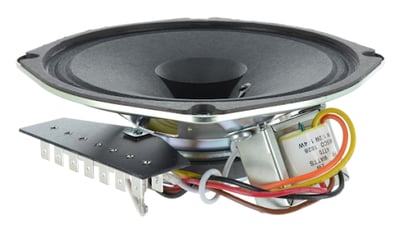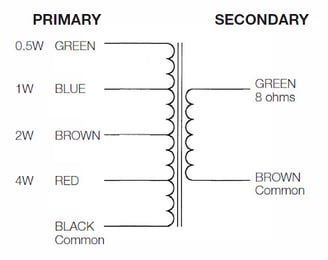Tips for Designing a Distributed Audio System
Early on, when the first speakers were being developed, only simple distributed audio systems existed and those used only a few speakers connected to an amplifier. In the 1920s, when large department stores sought to incorporate audio into the consumer shopping experience, and industrial facilities needed public address systems, the need arose for a simple way to deploy, control, and power large numbers of speakers from a single amplifier. Enter the constant voltage audio system.
Constant Voltage Distributed Audio Systems
In a constant voltage audio system, as the name implies, a constant carrier voltage is output by an amplifier, or an amplifier connected to a high voltage step-up transformer. Over the years, different voltage standards have been used—25 volts up to 200 volts—but 70 volts (70V) is the most common constant voltage standard, at least in America.
The high-level carrier voltage allows for very long wire runs with low loss—much like how electricity is distributed to homes and businesses—but this would destroy most lower impedance (4 Ohms to 32 Ohms) speakers connected directly to the line, since V2/R = power. Doing the math for a standard system means that 70V2/8 Ohms = 612.5 watts, which is dissipated across the speaker’s voice coil (very quickly).
To convert to a usable voltage level at the speaker, a step-down, line-matching transformer is required. Each step-down transformer is connected in parallel to the 70V line. This eases installation because you don’t need to calculate the impedance of a complex series-parallel wiring scheme. Also, since each speaker is in parallel, the performance of one speaker doesn’t affect the performance of another. If one speaker fails, the system still performs normally.
These transformers allow you to customize the output (SPL) of each connected speaker using different wattage tap settings. If a speaker is relatively close to listeners in one room, you can use the 0.5-watt (0.5W) tap. For a speaker in a much larger room, you might connect to the 4W tap. Each tap is connected to a different set of windings on the primary side of the transformer. The more windings, the higher the impedance and less power delivered to the secondary side of the transformer that connects to the speaker’s voice coil.


Additionally, you can easily group speakers into zones that connect to a single wall-mounted volume control. One volume control could adjust the volume for one to twenty (or more) speakers. There’s only one rule when it comes to 70V constant voltage distributed audio systems: Do not exceed the power capability of the amplifier. To prevent that, add up the tapped power settings of each speaker and make sure the sum is less than that of the amplifier’s power capacity (staying below 85% of the capacity is a good rule of thumb). For instance, a 100W amplifier can power 90 speakers tapped at 1W, 45 speakers tapped at 2W, 50 speakers tapped at 1W with 20 more speakers tapped at 2W… do the simple math that works for you, and leave a little extra wattage in the amp.
There’s only one rule when it comes to 70V constant voltage distributed audio systems: Do not exceed the power capability of the amplifier. To prevent that, add up the tapped power settings of each speaker and make sure the sum is less than that of the amplifier’s power capacity (staying below 85% of the capacity is a good rule of thumb). For instance, a 100W amplifier can power 90 speakers tapped at 1W, 45 speakers tapped at 2W, 50 speakers tapped at 1W with 20 more speakers tapped at 2W… do the simple math that works for you, and leave a little extra wattage in the amp.
Creating Your Distributed Audio System
MISCO is not as old as distributed audio systems, but we are close and have decades of experience manufacturing things like in-ceiling speakers and the transformers to help power them. We also have expertise related to system design that relies on Audio over Internet Protocol (AoIP). If you are looking for coaxial 2-way speakers or other assemblies designed for commercial applications, please contact us and we’d be happy to help you ideate around the best system that will deliver high-quality sound and last for decades. 
